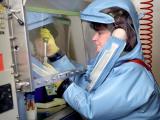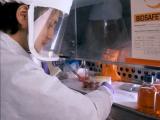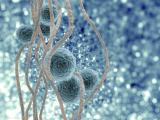As scientists continue to assess the pandemic potential of China's new H7N9 virus, a group of researchers said today that they hope to learn even more by taking the experiments to the next level: making and studying lab-modified strains that might be more transmissible and require tighter safety measures.
In a letter signed by 22 scientists that appeared in both Nature and Science today, researchers said some of the work will likely be considered gain-of-function (GOF) experiments, the type of testing that sparked controversy when two research groups published their findings on lab-modified H5N1 avian influenza strains that spread via airborne droplets among mammals.
At the same time, US government officials announced today that they would put federally funded H7N9 studies through an extra level of scientific and safety review.
The letter, signed by some of the same researchers from teams that published the controversial lab-modified H5N1 studies, detailed the type of experiments that might be defined as GOF, such as studies to explore the potential for drug resistance to emerge and what mutations and gene combinations might enhance the ability of H7N9 to more easily spread from person to person. The researchers also published a supplemental report that listed the precautions they would take when conducting any GOF experiments.
Extensive tests at other labs have already heightened concerns in global health circles that H7N9 might pose a bigger pandemic threat than H5N1, because the studies suggest that the new virus can easily infect human lung tissues and has a limited ability to spread by airborne droplets. So far H7N9 has been linked to 134 infections and 43 deaths, but the virus doesn't appear to spread easily from person to person.
Signers are part of NIH-funded network
Ron Fouchier, PhD, a virologist at Erasmus University in the Netherlands, told CIDRAP News that all of the scientists who signed the letter are part of the US National Institutes of Health (NIH)–funded Centers of Excellence for Influenza Research and Surveillance (CEIRS). The program, based at seven sites throughout the United States, is a National Institute of Allergy and Infectious Diseases (NIAID) research network that is designed to help the government and its global health partners prepare for and respond to epidemic and pandemic influenza threats.
He said the idea of the letter came up during the weekly teleconference sessions that involved CEIRS investigators during the first months of the H7N9 outbreak.
Fouchier said several experiments that were discussed and proposed qualify as GOF studies. "We rapidly agreed that some form of communication to the scientific community and general public would be desired," he said, adding that the group circulated the first draft of the letter by e-mail and then had a final discussion at the annual CEIRS meeting recently in Memphis.
Yoshihiro Kawaoka, DVM, PhD, who heads a research lab at the University of Wisconsin in Madison, is also part of the CEIRS network and among the signers of the letter. The group wants to be transparent about the proposed experiments, he told CIDRAP News. "We want to explain what we are doing and why, and describe the precautions we are taking."
Fouchier and Kawaoka led the teams that published the two controversial H5N1 studies last year.
The need to better inform the public and others about GOF experiments and the biosafety steps needed to conduct them safely were among the key lessons researchers learned during the H5N1 research debate. Scientists discussed communications issues in depth at a 2-day NIH conference in Washington, DC, in December, and the topic came up again at a meeting on general dual-use research issues in February at World Health Organization (WHO) headquarters in Geneva.
Five areas of GOF research listed
In their letter today, the researchers wrote that the H7N9 outbreak requires focused fundamental and applied research by responsible investigators working in appropriate facilities with key risk-mitigation plans in place. They outlined five areas of H7N9 study that are the most urgent and may warrant GOF experiments: immunogenicity, adaptation, drug resistance, transmission, and pathogenicity.
For example, they wrote that genetic changes that alter virulence, host range, or transmissibility could alter the antigenicity of vaccines, and anticipating such changes could help support the development of more effective vaccines to protect against the new virus.
GOF studies may also help health officials gauge the pandemic potential of H7N9 by exploring how likely it would be to better adapt to mammals and identifying what mutations or gene combinations might enhance transmissibility in mammals such as ferrets or guinea pigs, the group wrote. Researchers could also use GOF studies to determine if H7N9 viruses can reassort with other circulating viruses and if changes in the H7N9 virus might make it more pathogenic.
The proposed experiments are already subject to review by institutional biosafety committees and would be conducted with risk-mitigation plans that have already been developed for investigators who work with other potentially dangerous influenza viruses, such as the 1918 pandemic virus and H5N1.
They said more review layers may be required by funding agencies, and they pointed to a newly announced review process for H7N9 GOF studies (see below).
In a separate document on risk mitigation for H7N9 GOF experiments, the group emphasized nine key safety steps. For example, they said that studies should be designed to limit risks, such as by avoiding combinations of functional gains in areas such as increased virulence, host range, transmission, or drug resistance.
Since no vaccines for H7N9 are available, lab viruses should be tested to ensure that they are sensitive to oseltamivir, and if experimental changes alter resistance, scientists agree that those strains will not be used for any other GOF studies.
Feds announce extra review for H7N9 studies
In a related development today, US government officials announced a new review process for certain GOF experiments with the H7N9 virus, such as the ones proposed in the letter by the CEIRS researchers. In the same issues of Science and Nature the federal officials wrote that studies funded by the US Department of Health and Human Services (HHS) that could generate H7N9 viruses with increased airborne transmissibility in mammals will get an additional level of review.
The announcement would apply to NIH-funded research projects, including those conducted by CEIRS researchers. Officials wrote that the review would weigh potential benefits, along with biosafety and biosecurity risks, and would flag any additional safety steps that are needed. They also noted that the review will be done by standing expert panels using an approach similar to the assessment of lab-modified H5N1 studies.
Letter stirs questions on benefits, risks
An editorial in the same issue of Nature today said the influenza researchers' announcement could reignite some of the debate over last year's lab-modified H5N1 studies in ferrets and could prompt the first test of new oversight measures established in the wake of the debate.
Nature editors wrote that the long-term benefits of the research are clear, but added that the short-term benefits, such as providing public health with more tools to counter the H7N9 threat, aren't as apparent.
The journal pointed out that so far there is no evidence that the mutations that allow flu viruses to infect human cells—already seen in wild-type H7N9 viruses—predict the risk of a pandemic. Creating transmissible strains would go a step further and could reveal new clues about mutations that could affect transmission. "But nature could well come up with combinations for transmission that are different from those obtained in the experiments," the editorial noted.
Michael T. Osterholm, PhD, MPH, who heads a CEIRS center at the University of Minnesota and has been involved in the H5N1 debate as a member of the National Science Advisory Board for Biosecurity (NSABB), congratulated the US government for tightening its oversight of H7N9 GOF studies. He said that though he fully supports H7N9 research work, he still sees signs that researchers are overselling the benefits of the findings for public health uses such as supporting better flu surveillance systems. Osterholm is also director of the Center for Infectious Disease Research and Policy (CIDRAP), publisher of CIDRAP News.
He said an element that's still lacking is a risk-benefit analysis for this type of influenza experiment. "We need that oversight," Osterholm said, adding that he has aired his concerns with his CEIRS network colleagues.
Osterholm says he has full confidence in the biosafety steps used at labs such as Fouchier's and Kawaoka's, but he and others are still concerned that details about the experiments in scientific publications might enable labs in other parts of the world that don't have the same standards and oversight to replicate the work, which could pose a risk of an accidental release or allow dangerous viruses to be acquired for bioterror uses.
Fouchier RAM, Kawaoka Y, Cardona C, et al. Gain of function experiments on H7N9. (Letter) Science 2013 Aug 7 [Full text][Supplementary text]
Fouchier RAM, Kawaoka Y, Cardona C, et al. Gain of function experiments on H7N9. (Correspondence) Nature 2013 Aug 8;500:150-1 (published online Aug 7) [Full text] [Supplementary text]
Jaffee HW, Patterson AP, Lurie N. Avian flu: extra oversight for H7N9 experiments. (Letter) Science 2013 Aug 7 [Full text]
Jaffee HW, Patterson AP, Lurie N. Avian flu: extra oversight for H7N9 experiments. (Correspondence) Nature 2013 Aug 8;150:151 (published online Aug 7) [Full text]
Handle With Care. (Editorial) Nature 2013 Aug 8;500:121 (published online Aug 7) [Full text]




















